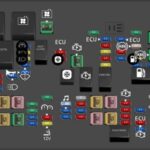Diagnostic Trouble Codes (DTCs) are essential for vehicle maintenance and repair. They provide valuable insights into the health of your car’s systems, allowing mechanics to quickly diagnose and fix problems. But what exactly is a DTC on OBD2, and how does it work? This article will delve into the details of DTCs, explaining their structure, interpretation, and significance in modern vehicle diagnostics.
Decoding DTCs: Structure and Meaning
A DTC on OBD2 (On-Board Diagnostics II) is a five-character alphanumeric code that represents a specific malfunction detected by the vehicle’s onboard computer. Each character provides crucial information about the nature and location of the problem.
The First Character: System Identification
The first character is always a letter and indicates the system where the fault originated:
- P: Powertrain (engine, transmission, emissions)
- B: Body (airbags, power seats, central locking)
- C: Chassis (ABS, suspension, steering)
- U: Network (communication systems between modules)
The Second Character: Code Type
The second character is a number:
- 0: Generic code (standardized across all OBD2 compliant vehicles)
- 1: Manufacturer-specific code (unique to the vehicle’s make)
The Third Character: Subsystem
The third character further narrows down the problem area within the identified system. For instance, within the Powertrain (P) category:
- 0: Fuel and Air Metering
- 1: Fuel and Air Metering (Injection System)
- 2: Fuel and Air Metering (Injection System)
- 3: Ignition System or Misfire
- 4: Auxiliary Emission Controls
- 5: Vehicle Speed Control and Idle Control System
- 6: Computer Output Circuit
- 7 & 8: Transmission
The Fourth and Fifth Characters: Specific Fault
The final two digits pinpoint the exact fault within the subsystem. For example, P0420 indicates a problem with the catalytic converter efficiency below threshold.
Example: Deciphering P0420
Let’s break down the common DTC P0420:
- P: Powertrain system
- 0: Generic OBD2 code
- 4: Auxiliary Emission Controls
- 20: Catalyst System Efficiency Below Threshold
This code signifies a potential issue with the catalytic converter, indicating it’s not functioning optimally.
 P04020 DTC code
P04020 DTC code
Beyond OBD2: J1939 for Heavy-Duty Vehicles
While OBD2 is the standard for light and medium-duty vehicles, heavy-duty vehicles often utilize the J1939 protocol. J1939 DTCs have a different structure, using four fields:
- Suspect Parameter Number (SPN): Identifies the specific component or system with the fault.
- Failure Mode Identifier (FMI): Describes the nature of the failure (e.g., short circuit, open circuit).
- Occurrence Counter (OC): Tracks how many times the fault has occurred.
- SPN Conversion Method (CM): Defines data handling for older diagnostic systems.
Utilizing DTCs for Effective Vehicle Maintenance
Understanding DTCs is crucial for efficient vehicle maintenance. Whether you use a handheld OBD2 scanner or a sophisticated telematics system, access to DTC information allows for:
- Prompt Diagnosis: Quickly identify the root cause of vehicle problems.
- Targeted Repairs: Avoid unnecessary repairs by focusing on the specific fault.
- Preventative Maintenance: Address potential issues before they become major problems.
- Improved Fleet Management: Monitor DTCs across multiple vehicles for proactive maintenance scheduling and optimized fleet performance.
Conclusion
DTCs are a fundamental part of modern vehicle diagnostics. Knowing what a DTC on OBD2 is and how to interpret it empowers car owners and fleet managers to make informed decisions about maintenance and repairs. By understanding these codes, you can ensure vehicle safety, reliability, and longevity.

